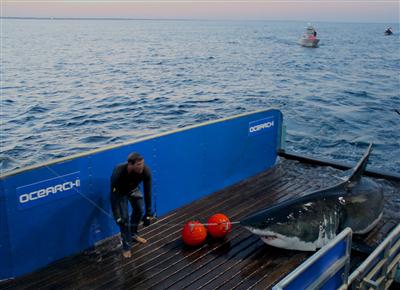OCRACOKE — Ocracoke Island had an unexpected visitor last week. Announced by the pings from her tracking device, maybe the most famous – legendary, even — shark outside of Hollywood swam along the island’s shore and briefly entered Ocracoke Inlet.
The Northern Atlantic great white shark, which has attained Internet fame as “Mary Lee,” is 16 feet long and reportedly weighs an amazing 3,456 pounds. She is one of 36 sharks—22 of them great whites–being tracked by scientists from the research facility, Ocearch. The mature female had been captured, outfitted with a tracking beacon on her dorsal fin and released on Sept. 17 off Cape Cod, and the world has followed her travels ever since.
Supporter Spotlight
Mary Lee has swum up and down the East Coast, going as far south as Jacksonville, Fla. Every time she rises to the surface, the beacon on her dorsal pings a satellite and a dot appears on people’s computer screens. Millions have logged onto the Internet to eagerly see the latest whereabouts of Mary Lee. Newspapers write about her coming visit, and bloggers note what she eats and speculate where she’ll next appear. A Google search for “Mary Lee shark” results in over a million hits. She even has her own Twitter account, and her Facebook page has more than 20,000 fans. It seems safe to say that no shark since that malevolent creature in “Jaws” has so captured the public’s attention.
 Mary Lee is tagged aboard the Ocearch research vessel. Photo: Ocearch |
A Web site tracks the movements of Mary Lee every time she comes to the surface. Photo: Ocearch |
“It’s thrilling that she’s become a rock star,” said Chris Fischer, one of the researchers at Ocearch. The shark he named after his mother has become, he said, “the most historic and legendary shark” ever tagged.
Fischer said that when one of the sharks being tracked swims too close to populated areas, he gives notice so that people can stay safe. That is what he did when Mary Lee approached Ocracoke on Jan. 21.
Ocearch first contacted the Hyde County Sherriff”s Dept., which called the Cape Hatteras National Park Service office at Ocracoke. Josh Vann, who took the call, immediately put it on Facebook. He then drove the beaches to make sure there were no surfers in the water, and he warned several fishermen who were fishing in the surf.
“She was very close to Ocracoke, North Carolina, either right on the beach right in front of it or actually inside the sound, nearby,” Fisher told CNN the next day. “A few hours later, she popped out off shore. She was very near there.”
Supporter Spotlight
It was Mary Lee’s second close encounter to the N.C. coast. She hung around the Cape Fear River for several days in early December.
Ocearch is a non-profit dedicated to studying the giants of the ocean. Begun by Fischer, who hosted the Emmy Award-winning television series, “Offshore Adventures,” it provides support for leading researchers and research institutions to conduct shark studies. Its 126-foot mother ship, the M/V Ocearch, is equipped with a 75,000-pound hydraulic lift, a research platform and a lab.
Researchers hope to learn more from Mary Lee and their other tagged sharks, particularly their medium- and long-range movement patterns. They are also interested in their reproductive behavior, the behavior of juveniles, identifying places where they might gather in large numbers and general life history. This knowledge will be useful in conservation efforts to protect sharks, which are declining worldwide.
Sharks are among the most awe-inspiring, feared and misunderstood creatures on Earth. They belong, along with rays and skates, to the class of fish, Chrondrichthyes, or “cartilage fish.” Their structure is supported not by bone, but by cartilage, a flexible, elastic material full of cell spaces. They have tough, abrasive skin and are, contrary to common lore, quite intelligent. Of the more than 300 species, most are too small to pose a threat to humans and some are benign plankton-feeders. Great whites, Carcharodon carcharias, are among the potentially dangerous species.
They are found in the coastal waters of all the great oceans. They belong to the Lamnidae family and are also known as “mackerel sharks,” because of the shape of their tails. Contrary to the great white in “Jaws,” the sharks seldom attack humans, preferring a diet of fish and marine mammals such as seals.
They are also not actually white, but may range from off-white to dark gray-brown, with white undersides. They have a circulatory modification known as a rete mirabile, or “wonderful net,” that allows them to maintain a higher body temperature than the water around them. This gives them extra energy for high speed chases and attacks.
Ocracoke is no stranger to visits from sharks. In July of 2011 a young girl was bitten by a shark while swimming off the island’s beach. She made a full recovery. Farther north, off Cape Hatteras in 2004, a man was attacked and killed by a shark. Spiny dog sharks are common inhabitants of the island’s waters in winter, often filling the fishing nets of commercial fishermen and providing a winter livelihood. Long-liners catch mako, black-tip, dusky and sandbar sharks in Ocracoke’s offshore waters, and huge whale sharks and basking sharks occasionally wash up on the beach. In May of 1997 islanders streamed by the Fish House to see a ten-foot, six-inch great white caught accidentally by a long-liner fishing for smaller sharks.
Great whites and other sharks, at the top of the ocean’s food chain, play a crucial role in maintaining a balance in marine ecosystems. Over-fishing threatens a number of species. With up to 25 percent of the great sharks facing extinction, research such as that being done with Mary Lee could play an important role in preserving them.








